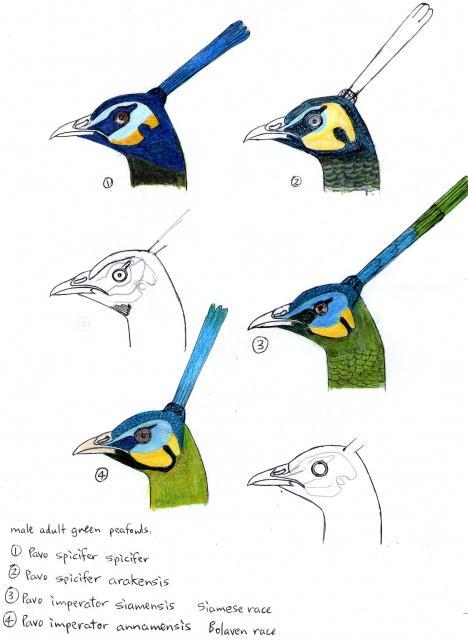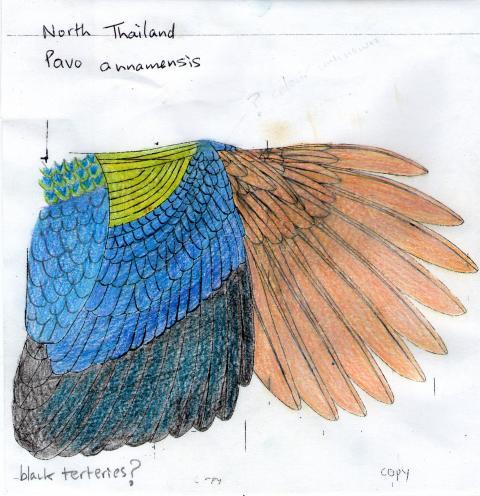- Jul 2, 2011
- 344
- 8
- 174
Hi Resolution,
My drawing of green peafowl, was from I copied & re-drawing the wings & body of feral IB peacock.
On 13th October 2006, my friend shot a adult feral IB peacock on farm, and when I brought the dead peacock, I had measured the train, tail, wing feathers and legs, body, leg spurs, head, beak.
When I drawing the wing, I held the wing flatten, before I mounted the wing & train.
When wing and train had dried up during mounting, I studied & measured the wing and train carefully, I had drawn the feathers of train & wing feathers, I held the wing flatten, on a board.
The feral IB peafowls are not flightless as they are good fliers, but they are less willing to fly and seem lacked the ablily to fly for more than 1 mile unlike wild peafowls that can fly for 10+ miles max.
When I were in Far North, I had approached the feral peafowls (both IB and BS) in farm, but they were wary and flew away.
Then all feral peafowls flew for 30 yards, at 6 feet from ground and into bushes in a group, I can see their wings which are flapping for 25 yards before they soar, then flapping again. The last bird to fly away, was a adult BS peacock, which took off when I walked toward it. It flew away for 30 yards. I had photoed the flying peafowls, but to my disappointment my photoes turned to of I made a mistake of choose the far rangle, instead of close rangle, with birds as specks in photoes.
Due to lack of photoes of mounted opened wings and photoes of trains of green peafowls, I cannot make anymore illustrations of 11 races of green peafowls and there is nothing known about measurement of bodies, trains of green peafowls and there are no clear sorting of 11 races of green peacocks by colours and size. I do not know very much about races of green peafowls and I only just learnt about this. I only make more illustrations of IB & BS peafowls.
To sort 11 races of green peafowls, you need to collect 22 freshly dead peafowls (11 males & 11 females), and measure them, lengthes of trains, body, heads, wingspans, distances between beak tips and eyes, and study the colours & pattens of plumages & trains, wings, heads, plus weights.
You need to get DNA from blood, by collect the blood from veins under wings, and sort the races of green peafowls.
Plus taxidermy gearing as borax & knifes, to rub in the skins of peafowls, and for skinning the birds. Borax harden the skins.
Bodyfats and meats & brain, eyes & tongues, oil grands have to be removed from skins, before rub in borax.
Photograping the birds have to in overcast weather as bright sunlight during sunny days cause birds to be pale coloured in photoes, with shadows, while in shadow of forest the birds appear darker or black in photoes.
Best photoes come from photograping in overcasting weather when shy is covered in clouds, with good light.
Your back must be toward sun when photograpinging birds.
Beware the colours of painting of plate of 11 races of green peafowls for fast identification purposes, may not be correct colours, and lacked the train feathers. I noticed the plate had pavo imperator siamensis with wrong colour (green) on wing coverts.
Clinton.
My drawing of green peafowl, was from I copied & re-drawing the wings & body of feral IB peacock.
On 13th October 2006, my friend shot a adult feral IB peacock on farm, and when I brought the dead peacock, I had measured the train, tail, wing feathers and legs, body, leg spurs, head, beak.
When I drawing the wing, I held the wing flatten, before I mounted the wing & train.
When wing and train had dried up during mounting, I studied & measured the wing and train carefully, I had drawn the feathers of train & wing feathers, I held the wing flatten, on a board.
The feral IB peafowls are not flightless as they are good fliers, but they are less willing to fly and seem lacked the ablily to fly for more than 1 mile unlike wild peafowls that can fly for 10+ miles max.
When I were in Far North, I had approached the feral peafowls (both IB and BS) in farm, but they were wary and flew away.
Then all feral peafowls flew for 30 yards, at 6 feet from ground and into bushes in a group, I can see their wings which are flapping for 25 yards before they soar, then flapping again. The last bird to fly away, was a adult BS peacock, which took off when I walked toward it. It flew away for 30 yards. I had photoed the flying peafowls, but to my disappointment my photoes turned to of I made a mistake of choose the far rangle, instead of close rangle, with birds as specks in photoes.
Due to lack of photoes of mounted opened wings and photoes of trains of green peafowls, I cannot make anymore illustrations of 11 races of green peafowls and there is nothing known about measurement of bodies, trains of green peafowls and there are no clear sorting of 11 races of green peacocks by colours and size. I do not know very much about races of green peafowls and I only just learnt about this. I only make more illustrations of IB & BS peafowls.
To sort 11 races of green peafowls, you need to collect 22 freshly dead peafowls (11 males & 11 females), and measure them, lengthes of trains, body, heads, wingspans, distances between beak tips and eyes, and study the colours & pattens of plumages & trains, wings, heads, plus weights.
You need to get DNA from blood, by collect the blood from veins under wings, and sort the races of green peafowls.
Plus taxidermy gearing as borax & knifes, to rub in the skins of peafowls, and for skinning the birds. Borax harden the skins.
Bodyfats and meats & brain, eyes & tongues, oil grands have to be removed from skins, before rub in borax.
Photograping the birds have to in overcast weather as bright sunlight during sunny days cause birds to be pale coloured in photoes, with shadows, while in shadow of forest the birds appear darker or black in photoes.
Best photoes come from photograping in overcasting weather when shy is covered in clouds, with good light.
Your back must be toward sun when photograpinging birds.
Beware the colours of painting of plate of 11 races of green peafowls for fast identification purposes, may not be correct colours, and lacked the train feathers. I noticed the plate had pavo imperator siamensis with wrong colour (green) on wing coverts.
Clinton.
























